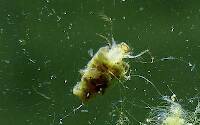
Blue-winged Olives
Baetis
Tiny Baetis mayflies are perhaps the most commonly encountered and imitated by anglers on all American trout streams due to their great abundance, widespread distribution, and trout-friendly emergence habits.
Featured on the forum

This wild-looking little thing completely puzzled me. At first I was thinking beetle or month larva, until I got a look at the pictures on the computer screen. I made a couple of incorrect guesses before entomologist Greg Courtney pointed me in the right direction with Psychodidae. He suggested a possible genus of Thornburghiella, but could not rule out some other members of the tribe Pericomini.

Troutnut is a project started in 2003 by salmonid ecologist Jason "Troutnut" Neuswanger to help anglers and
fly tyers unabashedly embrace the entomological side of the sport. Learn more about Troutnut or
support the project for an enhanced experience here.
PaulRoberts on Jul 13, 2012July 13th, 2012, 7:56 am EDT
While fishing a small warmwater lake in the Hudson Highlands of NY I found this Limnephilid caddis, at emergence time. I found pupal cases, and peeled out a pupa, and found some exuviae floating on the surface.
I'm guessing Phyrganea owing to the case, the olive abd, and the mottled wings you can see in the pupa. What do you think?



There was also a Heptageniid mayfly present. Nymphs that had gills that could be rapidly beat. They looked like small (#18) Macaffertium (owing to the wide banded femora). The odd thing was this was a 20 acre lake pond with 80+F water. I was snorkeling in it and it felt like bath water. I've seen may and stonefly larvae along large lake shores that are wave swept. But this forested lined pond was calm, and hot. The "lake" is a reservoir built in the 1920s and this mayfly is likely from the nearby (although tiny and almost ephemeral) streams.
Hah! As luck would have it, in the edge of the pupal case image is one of the mays. I cut t out and here it is -a rather small one as they varied in size a good hook size or more. With the pale spot at then end of the abd, it looks a bit like Cinygmula:

I'm guessing Phyrganea owing to the case, the olive abd, and the mottled wings you can see in the pupa. What do you think?



There was also a Heptageniid mayfly present. Nymphs that had gills that could be rapidly beat. They looked like small (#18) Macaffertium (owing to the wide banded femora). The odd thing was this was a 20 acre lake pond with 80+F water. I was snorkeling in it and it felt like bath water. I've seen may and stonefly larvae along large lake shores that are wave swept. But this forested lined pond was calm, and hot. The "lake" is a reservoir built in the 1920s and this mayfly is likely from the nearby (although tiny and almost ephemeral) streams.
Hah! As luck would have it, in the edge of the pupal case image is one of the mays. I cut t out and here it is -a rather small one as they varied in size a good hook size or more. With the pale spot at then end of the abd, it looks a bit like Cinygmula:

Entoman on Jul 13, 2012July 13th, 2012, 10:00 am EDT
Cool series of photos, Paul.
Caddis: I agree it's Phryganeidae. I'm torn between Phryganea and Banksiola. I can't make out any characters that really help me tell between the two, so based on the dark thorax and greenish body, I'll go with Phryganea. For me the problem is Banksiola can have this coloration as well out West and the heavily blotched wings are also characteristic. What descriptions I can find of the genus on the East Coast describe it as a lighter pupa. Creno? Very cool photo of the pupa by the way. You captured the "shrink wrapped" look perfectly.
Mayfly Nymph: It's hard to make out, but I believe we may be looking at Arthroplea bipunctata. It is in a similar looking family to Heptageniidae, but can live in warmer weedy lakes and ponds without much wave action. In fact, it prefers no wave action.http://www.pbase.com/tmurray74/image/61455511 and http://www.discoverlife.org/mp/20p?&res=md&see=I_DSC80;&start=/mp/20q%3Fsearch%3DArthroplea
Caddis: I agree it's Phryganeidae. I'm torn between Phryganea and Banksiola. I can't make out any characters that really help me tell between the two, so based on the dark thorax and greenish body, I'll go with Phryganea. For me the problem is Banksiola can have this coloration as well out West and the heavily blotched wings are also characteristic. What descriptions I can find of the genus on the East Coast describe it as a lighter pupa. Creno? Very cool photo of the pupa by the way. You captured the "shrink wrapped" look perfectly.
Mayfly Nymph: It's hard to make out, but I believe we may be looking at Arthroplea bipunctata. It is in a similar looking family to Heptageniidae, but can live in warmer weedy lakes and ponds without much wave action. In fact, it prefers no wave action.http://www.pbase.com/tmurray74/image/61455511 and http://www.discoverlife.org/mp/20p?&res=md&see=I_DSC80;&start=/mp/20q%3Fsearch%3DArthroplea
"It's not that I find fishing so important, it's just that I find all other endeavors of Man equally unimportant... And not nearly as much fun!" Robert Traver, Anatomy of a Fisherman
PaulRoberts on Jul 13, 2012July 13th, 2012, 10:38 am EDT
Arthroplea. Never heard of such a critter. Interesting.
Wish I had images now. I do believe the legs were much wider than the Arthro images on the sites you provide. Are there other species of Arthroplea?
Now reading about Arthroplea, and looking closer, I think mine was not Arthroplea. It's described as having a notable swimming behavior, and the images show a build similar to Leptoplebia (a may that also inhabits these ponds but at the inlets). The ones I saw were very flat clingers that took a thumbnail to remove and when dropped in did not swim.
Wish I had images now. I do believe the legs were much wider than the Arthro images on the sites you provide. Are there other species of Arthroplea?
Now reading about Arthroplea, and looking closer, I think mine was not Arthroplea. It's described as having a notable swimming behavior, and the images show a build similar to Leptoplebia (a may that also inhabits these ponds but at the inlets). The ones I saw were very flat clingers that took a thumbnail to remove and when dropped in did not swim.
Entoman on Jul 13, 2012July 13th, 2012, 10:59 am EDT
I do believe the legs were much wider than the Arthro images on the sites you provide.
Possibly, but because the legs are shaped like airplane wings in cross section, photo angles and the way the legs are held in them can be deceptive regarding perceived width. Habitat and the characters of long slim abdomen, shape of head, eye placement, slimmer terminal filament, and they way you describe the gills make this specimen hard to place anywhere else.
Are there other species of Arthroplea?
Not in North America. I believe the family may be monotypical, but I'm not up on world fauna and don't know the status of the original type species which I believe wasn't nearctic in origin.
Is it possible this could be a photo of a different critter than the ones you handled? I'm beginning to suspect that based on your descriptions of the looks and behavior of the critters you collected. The reason I ask is because you mentioned it was an artifact found in the pupa photo and not one taken intentionally of the critters you've been describing. Of course that still doesn't explain the habitat issue. One last point - the head/thorax length to abdomen length ratio of this specimen is hard to fit with Heptageniidae. Depending on where you place the anterior margin of the head capsule, measuring from there to the tips of the wing pads is half of the abdomen length.
"It's not that I find fishing so important, it's just that I find all other endeavors of Man equally unimportant... And not nearly as much fun!" Robert Traver, Anatomy of a Fisherman
PaulRoberts on Jul 13, 2012July 13th, 2012, 11:26 am EDT
Is it possible this could be a photo of a different critter than the ones you handled? I'm beginning to suspect that based on your descriptions of the looks and behavior of the critters you collected. The reason I ask is because you mentioned it was an artifact found in the pupa photo and not one taken intentionally of the critters you've been describing. Of course that still doesn't explain the habitat issue. One last point - the head/thorax length to abdomen length ratio of this specimen is hard to fit with Heptageniidae.
Entirely possible. I didn't expect two considering the habitat. The one above does look different from what I recall of the larger ones: Slimmer abdomen, with proportionally wider anterior areas. The larger ones I plucked and looked at in water cupped in my hand looked like Macaffertium to me.
Oh yes... There was a drowned dun I found too, at the same site. It was very pale, whitish almost, with notable dark eyes; It reminded me of Ephoron, but was not. I was busy with other things so I didn't take careful note of details. I do believe it had two tails, and was a ~size 16/15.
Entoman on Jul 13, 2012July 13th, 2012, 11:40 am EDT
The duns are dark, looking like a cross between Epeorus and Leptophlebia. They have two tails and run about 8mm, give or take a little. The mature nymphs are dark as well and listed as ranging between 8 & 10mm in Mayflies of North and Central America. Immatures often have pale terminal terga. The duns you found certainly indicate the presence of Heptageniidae. More evidence of two species?
"It's not that I find fishing so important, it's just that I find all other endeavors of Man equally unimportant... And not nearly as much fun!" Robert Traver, Anatomy of a Fisherman
PaulRoberts on Jul 13, 2012July 13th, 2012, 12:40 pm EDT
Thanks, Kurt. As it stands, it'll be next June before I will get back to them again.
Entoman on Jul 13, 2012July 13th, 2012, 1:16 pm EDT
You're welcome, thanks for sharing. Hopefully you'll find them again!
"It's not that I find fishing so important, it's just that I find all other endeavors of Man equally unimportant... And not nearly as much fun!" Robert Traver, Anatomy of a Fisherman
GONZO on Jul 14, 2012July 14th, 2012, 8:29 am EDT
Hi Paul,
Just a few alternative thoughts about your "heptageniids":
Although a few Maccaffertium species can be found in lakes, Stenonema femoratum and one of the versions of Stenacron interpunctatum are commonly found there. Either species would seem to be a better fit for "very flat clingers that took a thumbnail to remove" than Arthroplea bipunctata. Because their range extends much further into the south, I suspect that their tolerance for warm water is probably greater than A. bipunctata.
A. bipunctata, in addition to having bizarrely elongated maxillary palps (the things that make the heads look so large and round in Kurt's linked photos), is frequently found clambering on submerged vegetation in "temporary" habitat, like northern vernal ponds and overflow areas of streams. It usually emerges in May through June and has a univoltine "spring" life cycle with the eggs presumably remaining in diapause through winter.
Just a few alternative thoughts about your "heptageniids":
Although a few Maccaffertium species can be found in lakes, Stenonema femoratum and one of the versions of Stenacron interpunctatum are commonly found there. Either species would seem to be a better fit for "very flat clingers that took a thumbnail to remove" than Arthroplea bipunctata. Because their range extends much further into the south, I suspect that their tolerance for warm water is probably greater than A. bipunctata.
A. bipunctata, in addition to having bizarrely elongated maxillary palps (the things that make the heads look so large and round in Kurt's linked photos), is frequently found clambering on submerged vegetation in "temporary" habitat, like northern vernal ponds and overflow areas of streams. It usually emerges in May through June and has a univoltine "spring" life cycle with the eggs presumably remaining in diapause through winter.
PaulRoberts on Jul 14, 2012July 14th, 2012, 8:40 am EDT
Thanks for your input, Lloyd.
Your description of Arthroplea also jives with the other I read, indicating habits and habitat more similar to Leptophlebia than the Heptageniids.
It wasn't Stenacron either. I believe I can recognize them pretty readily.
I looked up Stenonema femoratum and the nymphs have the right body plan I saw in that little lake:
http://bugguide.net/node/view/250236
And the Ephoron-colored dun I saw matches pretty well with the one labelled S. femoratum in the following link:
http://www.cirrusimage.com/ephemeroptera_mayfly_Stenonema_femoratum.htm
S. femoratum is the best fit -until next June.
Your description of Arthroplea also jives with the other I read, indicating habits and habitat more similar to Leptophlebia than the Heptageniids.
It wasn't Stenacron either. I believe I can recognize them pretty readily.
I looked up Stenonema femoratum and the nymphs have the right body plan I saw in that little lake:
http://bugguide.net/node/view/250236
And the Ephoron-colored dun I saw matches pretty well with the one labelled S. femoratum in the following link:
http://www.cirrusimage.com/ephemeroptera_mayfly_Stenonema_femoratum.htm
S. femoratum is the best fit -until next June.
GONZO on Jul 14, 2012July 14th, 2012, 9:11 am EDT
Sorry, Paul...looks like I messed up the first of your links by trying to compress it. (The extreme length of the links was blowing out the frame of the text boxes making them hard to read on my browser.) Here are some additional images of S. femoratum showing the wide range of dark-to-light variability found in that species:
S. femoratum
S. femoratum
S. femoratum
S. femoratum
In addition, S. femoratum can have a nearly season-long emergence in warmwater habitats. This might help to explain how you would see an immature nymph and a dun at the same time.
S. femoratum
S. femoratum
S. femoratum
S. femoratum
In addition, S. femoratum can have a nearly season-long emergence in warmwater habitats. This might help to explain how you would see an immature nymph and a dun at the same time.
PaulRoberts on Jul 14, 2012July 14th, 2012, 9:48 am EDT
In addition, S. femoratum can have a nearly season-long emergence in warmwater habitats. This might help to explain how you would see an immature nymph and a dun at the same time.
Ah! Yes, that would explain the varying sizes.
Interesting color variations too in those links you provided. A bit like M. vicarium, but more so.
Apologies for the long links. I was lazy -taking it directly from Google Images. Won't do that again. Fixed em above.
Thanks, Lloyd.
Entoman on Jul 14, 2012July 14th, 2012, 11:31 am EDT
Thanks Lloyd, for clearing up the habitat issue. I had no idea heptageniids could live in weedy warmwater ponds without movement or any stillwater without a lot of wave action, for that matter. Based on the behavior and appearance in the hand Paul is describing, that would seem to be the answer. But then there's that pesky photo... Could we indeed be talking about two different species as I mentioned above? As I also said above, you can't make much out but what can be seen is hard to jive with Stenacron or Stenonema, immature or otherwise, IMO. The abdomen is much to long and uniformly tapered, almost like a damselfly. The eyes spread well beyond the head capsule margins to the side and with a substantial amount of head out in front of them at the anterior margin. Coupled with the environment and locale I still think Arthroplea bipunctata is a good fit, at least for the critter in the photo. :)
Arthroplea bipunctata is a hard species to find much about, but Edmunds describes them in Mayflies of North and Central America as preferring ponds or channels with very little if any water movement. He mentions they are often found in the same habitat as Nothern Aedes mosquitoes! So much for trout habitat.:) As to their lack of a more southerly distribution being an indicator of their temperature tolerance vis-a-vis Stenonema or Stenacron, I'm not sure. I suspect it has more to do with their love of small water without movement. The larger waters with wave action preferred by the latter species can stay cooler much further south.
BTW - Another character that should be mentioned besides the unusual palps are the gills, which are pointed apically like an arrowhead and with heavy tracheation.
Arthroplea bipunctata is a hard species to find much about, but Edmunds describes them in Mayflies of North and Central America as preferring ponds or channels with very little if any water movement. He mentions they are often found in the same habitat as Nothern Aedes mosquitoes! So much for trout habitat.:) As to their lack of a more southerly distribution being an indicator of their temperature tolerance vis-a-vis Stenonema or Stenacron, I'm not sure. I suspect it has more to do with their love of small water without movement. The larger waters with wave action preferred by the latter species can stay cooler much further south.
BTW - Another character that should be mentioned besides the unusual palps are the gills, which are pointed apically like an arrowhead and with heavy tracheation.
"It's not that I find fishing so important, it's just that I find all other endeavors of Man equally unimportant... And not nearly as much fun!" Robert Traver, Anatomy of a Fisherman
GONZO on Jul 14, 2012July 14th, 2012, 12:03 pm EDT
Could we indeed be talking about two different species as I mentioned above?
Sure, it's possible, Kurt, but you draw a lot of conclusions about a very indistinct photo that I simply don't share.
As to their lack of a more southerly distribution being an indicator of their temperature tolerance vis-a-vis Stenonema or Stenacron, I'm not sure. I suspect it has more to do with their love of small water without movement. The larger waters with wave action preferred by the latter species can stay cooler much further south.
Berner (1988) said this about S. interpunctatum in sand-bottomed lakes in Florida:
In the lakes, the insects confine themselves to that part entirely free of silt and characterized by cleanly washed sand shore and beach. There is little wave action or deposition of silt in this region.
The range of S. femoratum stretches through Texas into northern Mexico. Are you saying that there is a lack of small water without movement for A. bipunctata to inhabit in the south?
Entoman on Jul 14, 2012July 14th, 2012, 2:04 pm EDT
Lloyd -
Yes, I admit to having trouble correlating what I see in the photo with what little I know about Stenonema/Stenacron morphology. Where the head characters begin and the underlying surface ends is hard to make out but something's "not right around the house" about it. The abdomen though isn't so ambiguous. That's why I'm leaning towards a different species for what appears in the photo. As far as what Paul saw and handled, I have no reason to conclude anything different from what the two of you have been discussing. Absent direct physical evidence, your information regarding habitat coupled with Paul's descriptions confirm the presence of heptageniids about as strongly as possible under the circumstances.
No, only suggesting the possibility that their different habitat preferences may be a more important factor in distribution than temperature tolerances. In addition to the water preferred by heptageniids not always necessarily being warmer in the South than the frog water Arthroplea prefers further North, another factor to consider is oxygen levels. Most studies I've read mention the stillwater heptageniid's need for reasonably clean aggregate of varing sizes from sand to boulder and with some wave action. I can't speak to Berner other than to note they weren't found in weedy water with a silty substrate, which would have been more to the point by way of comparison. I assume the clean sandy area meets their requirements as less oxygen is removed from the water due to the breakdown of silt and the lack of weeds for preventing even more being taken at night. Perhaps their ecclosion, growth, and emergence takes place before temperatures get very high? In any event, I'm not aware of any temperature data that could be used to compare their tolerances assuming adequate oxygen levels. BTW - I didn't mention this as a rationale for or against the species under discussion as possibilities for what's in the photo - just unnecessarily broadening the conversation.:)
Sure, it's possible, Kurt, but you draw a lot of conclusions about a very indistinct photo that I simply don't share.
Yes, I admit to having trouble correlating what I see in the photo with what little I know about Stenonema/Stenacron morphology. Where the head characters begin and the underlying surface ends is hard to make out but something's "not right around the house" about it. The abdomen though isn't so ambiguous. That's why I'm leaning towards a different species for what appears in the photo. As far as what Paul saw and handled, I have no reason to conclude anything different from what the two of you have been discussing. Absent direct physical evidence, your information regarding habitat coupled with Paul's descriptions confirm the presence of heptageniids about as strongly as possible under the circumstances.
The range of S. femoratum stretches through Texas into northern Mexico. Are you saying that there is a lack of small water wihout movement for A. bipunctata to inhabit in the south?
No, only suggesting the possibility that their different habitat preferences may be a more important factor in distribution than temperature tolerances. In addition to the water preferred by heptageniids not always necessarily being warmer in the South than the frog water Arthroplea prefers further North, another factor to consider is oxygen levels. Most studies I've read mention the stillwater heptageniid's need for reasonably clean aggregate of varing sizes from sand to boulder and with some wave action. I can't speak to Berner other than to note they weren't found in weedy water with a silty substrate, which would have been more to the point by way of comparison. I assume the clean sandy area meets their requirements as less oxygen is removed from the water due to the breakdown of silt and the lack of weeds for preventing even more being taken at night. Perhaps their ecclosion, growth, and emergence takes place before temperatures get very high? In any event, I'm not aware of any temperature data that could be used to compare their tolerances assuming adequate oxygen levels. BTW - I didn't mention this as a rationale for or against the species under discussion as possibilities for what's in the photo - just unnecessarily broadening the conversation.:)
"It's not that I find fishing so important, it's just that I find all other endeavors of Man equally unimportant... And not nearly as much fun!" Robert Traver, Anatomy of a Fisherman
PaulRoberts on Jul 15, 2012July 15th, 2012, 10:18 am EDT
A bit about the habitat these mayflies were found in:
A 20 acre acidic reservoir bedded in gneiss and granite that appears "mesotrophic" without very much rooted vegetation (mostly Nitella) and a mostly sand/muck shoreline with muck in the depths. The mays were found along a shoreline on and under boulders and large cobbles. The boulders were a dark root-beer color owing I assume to tannins in the water (receives a large load of allochthonous input) and possibly diatom growth. This spot was at the tip of a point of land jutting a short way into the lake (into deep water), and the rocks may have been cleared of silt/muck by wave action due to the sites exposure, although as stated before waves are not likely a consistent feature of the lake shore.
A 20 acre acidic reservoir bedded in gneiss and granite that appears "mesotrophic" without very much rooted vegetation (mostly Nitella) and a mostly sand/muck shoreline with muck in the depths. The mays were found along a shoreline on and under boulders and large cobbles. The boulders were a dark root-beer color owing I assume to tannins in the water (receives a large load of allochthonous input) and possibly diatom growth. This spot was at the tip of a point of land jutting a short way into the lake (into deep water), and the rocks may have been cleared of silt/muck by wave action due to the sites exposure, although as stated before waves are not likely a consistent feature of the lake shore.
Entoman on Jul 15, 2012July 15th, 2012, 11:43 am EDT
Great habitat info, Paul. It sure precludes the possibility of Arthroplea for the nymph in the photo. My understanding is they prefer the kind of frog water where even a Leptophlebiid would fear to tread.:) In light of this latest habitat evidence, I can't explain the anomolies in the photo other than to agree with Lloyd that an immature Stenonema can apparently look like this. I've learned a lot in this thread, thanks to you both.
"It's not that I find fishing so important, it's just that I find all other endeavors of Man equally unimportant... And not nearly as much fun!" Robert Traver, Anatomy of a Fisherman
Creno on Jul 15, 2012July 15th, 2012, 2:43 pm EDT
re limnephilid/phryganeid - the photos have too much glare to really determine what they are. The critter should be submersed for a better pic. One can see enough of the empty pupal case posterior to say it is a phryganeid but anything more based on these pics is really just guessing. And, as usual, length always helps in determination. To say that a pupae extracted from a case is the same as a cast skin found floating is also a stretch needing further comparison. Often many different phryganeids inhabit the same locations.
PaulRoberts on Jul 15, 2012July 15th, 2012, 3:05 pm EDT
Thanks, Dave. I'll try shooting them submersed next time.
Quick Reply
Related Discussions
Topic
Replies
Last Reply
18
Nov 20, 2007
by Shawnny3
by Shawnny3
2
Jul 14, 2008
by Wiflyfisher
by Wiflyfisher
Re: Biggest bluegills I've seen since I left Texas (subtitled: FINALLY wet a fly line!) 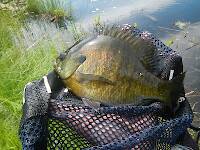
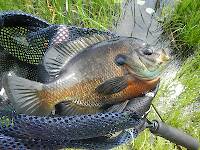

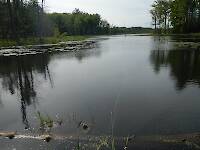
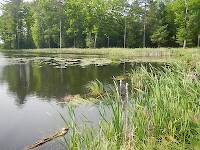
In the Photography Board by Jmd123
+ 5





In the Photography Board by Jmd123
6
Jun 10, 2018
by Jmd123
by Jmd123
Re: Possible upcoming trip to North Dakota - any good trout waters???
In General Discussion by Jmd123
In General Discussion by Jmd123
5
Sep 3, 2009
by Jmd123
by Jmd123
2
Feb 2, 2018
by PaulRoberts
by PaulRoberts
0
Sep 23, 2006
by Litobrancha
by Litobrancha





